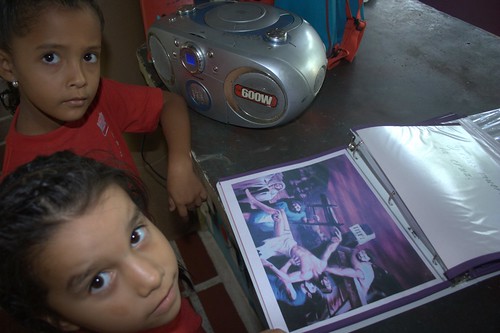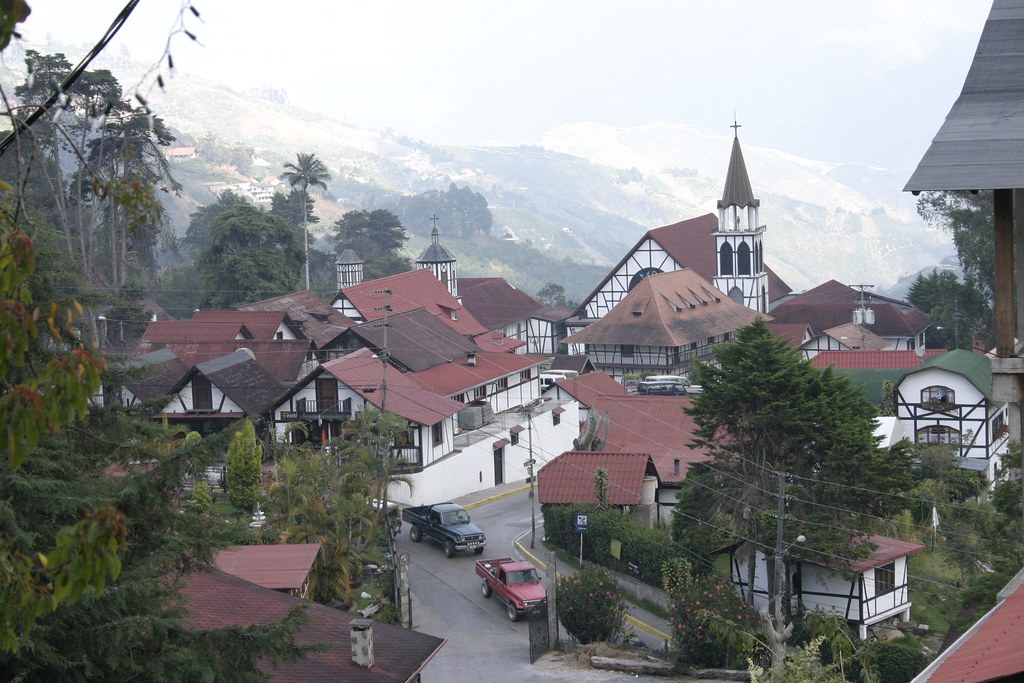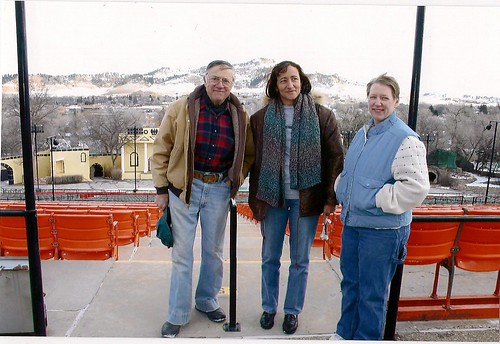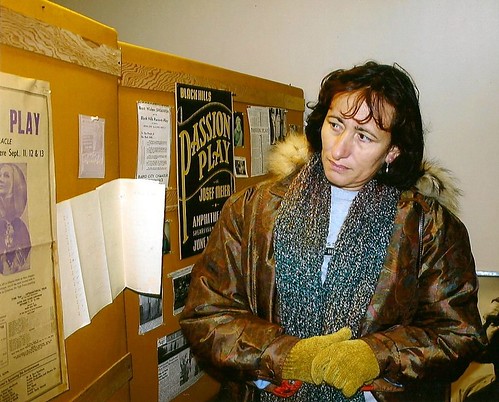
Although we have a small group of people that have been baptized and confirmed as Lutherans, our mission actually serves a somewhat wider community. Because there are so few schools with any kind of Christian orientation here, some of the people who send their children to our preschool are devout Roman Catholics or Pentecostalists. The father of one of our little girls is the pastor of a Pentecostalist church, while two of our preschool teachers are Catholic (ideally, all of our teachers would be Lutheran, but Venezuelan law dictates that the preschool have a certain number of state-certified teachers and there are not that many state-certified Lutheran teachers here).
Of course we do not demand that faithful members of other churches join ours in order to send their children to our preschool. Attendance at our Sunday services is alway be invitation. Therefore, we strive to maintain a solidly Lutheran position in doctrine and practice while respecting the beliefs of those who subscribe to other confessions.
The preschool will be closed for Holy Week, therefore we are using this week to teach the preschool children that Holy Week means something other than vacation time. One of our teachers, Yosaira, had approached me with her huge family Bible. It was a "Catholic" Bible, including the "deuterocanonical" books in its Old Testament and some beautiful color-plate illustrations of the traditional Stations of the Cross. Yosaira thought perhaps we could scan the illustrations and use them to teach the children about the events of Good Friday.
The Stations of the Cross were first mentioned in writings from the fifth and sixth centuries as a series of numbered stops for pilgrims to meditate and pray while retracing the Via Dolorosa, or Christ's path from the Garden of Gethsemane to Golgotha, in Jerusalem. Supposedly these were places where Jesus paused on His way to the Cross, except for the last four which involve Him actually being nailed to the cross, dying, and being taken down and laid in the tomb. Eventually a list of 14 "stations" became the accepted norm and every year to this day hundreds of Christian pilgrims to Jerusalem follow this pattern in following the Via Dolorosa.
 Somewhat later, since relatively few people had the time or money to travel to Jerusalem, it became a devotional practice to recreate the path to the Cross with paintings or crosses along a circumscribed route in a church or elsewhere. For example, in Colonia Tovar, a German-Catholic enclave in the mountains north of Caracas, the main street of the town is marked with crosses representing the Stations of the Cross as it winds down to its end at St. Martin of Tours Church.
Somewhat later, since relatively few people had the time or money to travel to Jerusalem, it became a devotional practice to recreate the path to the Cross with paintings or crosses along a circumscribed route in a church or elsewhere. For example, in Colonia Tovar, a German-Catholic enclave in the mountains north of Caracas, the main street of the town is marked with crosses representing the Stations of the Cross as it winds down to its end at St. Martin of Tours Church.The imagery of the Stations of the Cross have provided inspiration for Christian art for centuries. Not only paintings and sculpture, but also Christian theater, as the European "Passion Play" tradition incorporates dramatizations of the various stations. This includes Mel Gibson's movie, "The Passion of the Christ," which is essentially a Passion Play on film (see postscript on Passion Plays).
However, there is a problem with the traditional Stations of the Cross: Not all of them are really part of any of the New Testament narratives. The traditional 14 Stations of the Cross are as follows:
- Jesus is condemned to death
- Jesus is given his cross
- Jesus falls the first time
- Jesus meets His mother
- Simon of Cyrene carries the cross
- St. Veronica wipes the face of Jesus
- Jesus falls the second time
- Jesus meets the daughters of Jerusalem
- Jesus falls the third time
- Jesus is stripped of His garments
- Jesus is nailed to the cross
- Jesus dies on the cross
- Jesus' body is removed from the cross
- Jesus is laid in the tomb and covered in incense
- Jesus in the Garden of Gethsemane
- Jesus is betrayed by Judas and arrested
- Jesus is condemned by the Sanhedrin
- Jesus is denied by Peter
- Jesus is judged by Pilate
- Jesus is scourged and crowned with thorns
- Jesus takes up His cross
- Jesus is helped by Simon to carry His cross
- Jesus meets the women of Jerusalem
- Jesus is crucified
- Jesus promises His kingdom to the repentant thief
- Jesus entrusts Mary and John to each other
- Jesus dies on the cross
- Jesus is laid in the tomb
- Jesus rises from the dead on the third day
I told Yosaira I would have no problem with using this form of the Stations of the Cross. We used most of the pictures from her Bible and I filled in the gaps with graphics from the Wisconsin Synod Web site.
There is another problem with the Roman Catholic interpretation of the Stations of the Cross and that is this form of devotion still is considered an "act of reparation" or, in essence, a meritorious work.
CATHOLIC ENCYCLOPEDIA: Reparation
"Reparation is a theological concept closely connected with those of atonement and satisfaction, and thus belonging to some of the deepest mysteries of the Christian Faith. It is the teaching of that Faith that man is a creature who has fallen from an original state of justice in which he was created, and that through the Incarnation, Passion, and Death of the Son of God, he has been redeemed and restored again in a certain degree to the original condition. Although God might have condoned men's offences gratuitously if He had chosen to do so, yet in His Providence He did not do this; He judged it better to demand satisfaction for the injuries which man had done Him. It is better for man's education that wrong doing on his part should entail the necessity of making satisfaction. This satisfaction was made adequately to God by the Sufferings, Passion, and Death of Jesus Christ, made Man for us. By voluntary submission to His Passion and Death on the Cross, Jesus Christ atoned for our disobedience and sin. He thus made reparation to the offended majesty of God for the outrages which the Creator so constantly suffers at the hands of His creatures. We are restored to grace through the merits of Christ's Death, and that grace enables us to add our prayers, labours, and trials to those of Our Lord "and fill up those things that are wanting of the sufferings of Christ" (Colossians 1:24). We can thus make some sort of reparation to the justice of God for our own offences against Him, and by virtue of the Communion of the Saints, the oneness and solidarity of the mystical Body of Christ, we can also make satisfaction and reparation for the sins of others."Certainly Colossians 1:24 read in context does not support the above assertions. Paul writes in Colossians of the redemptive work of Christ as being sufficient to atone for all the sins of all men. In verse 24, he says that he is able to endure "the sufferings of Christ", that is, the difficulties that he, as a preacher of the Word, experiences above and beyond the normal problems of life for the sake of Christ, as being something that will benefit Christ's body, the Church. If he, Paul, is able to endure these sufferings, then perhaps the Church will be spared some suffering for the sake of Christ. But as in baptism Christians share in the resurrection of Christ, they also will share some of the same sufferings as Christ (persecution and rejection by the world). In no sense, however, do our sufferings add anything, or need to add anything, to the price Christ paid for our sins on the cross.
I addressed this issue in an introductory talk to parents and children on Monday and again in my presentation of the pictures on Wednesday, saying that our worship and praise during Holy Week were not required of us to earn His love and favor, but rather were our response to what Jesus did for us on the cross. Through His suffering and death on the cross He paid the full price for our sins and that therefore we are justified before God through faith in Him, not through any of our works. Therefore, the Stations of the Cross ares simply a tool for us to remember and appreciate Christ's sacrifice for us.
No preschool next week, but our Holy Week schedule includes services on Palm Sunday, Good Friday and Easter Sunday.

Postscript on Passion Plays
When Luz Maria and I visited my family in South Dakota in 2006, we stopped at the Spearfish Amphitheater in Spearfish, S.D., which for nearly 70 years was the main venue for the Black Hills Passion Play. The Black Hills Passion Play was presented on a 350-foot outdoor stage with seating for 6,000 people. Performances were Tuesdays, Thursdays and Sundays during the summer months.
In 1932 a troupe of Passion Players from Lünen, Germany, where a Passion Play had been presented since 1242, began touring the United States. One of them was Josef Meier,
a seventh-generation Passion Player. Their script was in German, which meant their engagements were limited to theaters and churches frequented by German-speaking immigrants. Because of political and economic conditions in Germany, Meier decided to stay in the United States. He had the script translated into English, hired American actors to replace the German cast, and while touring various towns, began looking for a permanent home for his Passion Play.

Spearfish was chosen in part because of the site's excellent natural acoustics. The amphitheater was built in 1939. During its heyday, the Black Hills Passion Play company not only made special appearances throughout the United States and Canada, but in 1953 established a winter home in Lake Wales, Florida, where the play was presented until 1998.
There were no performances scheduled for the winter of 2006, but Luz Maria and I were given a personal tour of the Black Hills Passion Play Museum by Guido Della Vecchia, husband of Johanna Meier, Josef's daughter. Guido spoke Italian while Luz Maria spoke Spanish, and they were able to communicate to a limited extent.
So I was saddened to learn that the Black Hills Passion Play gave its final performance in 2008. For me, the Passion Play was always part of the Black Hills, just like Mount Rushmore, the Crazy Horse monument and the Needles. I understand the museum is still open.
![Reblog this post [with Zemanta]](http://img.zemanta.com/reblog_e.png?x-id=ebb7df21-2ee5-4238-8b64-32fcb4e69e5b)
No comments:
Post a Comment